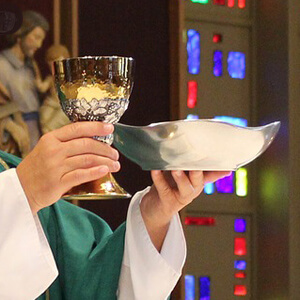
When the host and the chalice are consecrated at Mass, each part of the host, and each drop of the chalice, is transformed into the totality of the glorified Christ, that is, the Body, Blood, Soul and Divinity of our Lord, Jesus Christ.
Traditionally, when we refer to the consecrated host as “Body of Christ” and the consecrated chalice as “Blood of Christ”, that was merely for ease of reference, but not technically accurate in reality. The consecrated host is the Body, Blood, Soul and Divinity of Christ, and the chalice is the Body, Blood, Soul and Divinity of Christ. Receiving one or the other is receiving the whole Christ. Indeed, technically, there is no need to receive both.
In fact, because of the greater danger to spillage and abuse, for many centuries, the Church has withheld the chalice from the faithful, reasoning that it is sufficient to receive the host alone, for it is the whole Christ.
The chalice was re-introduced into the eucharistic liturgy at Vatican II, not because the host is insufficient, but rather has a way to enrich the symbolism and the overabundance of God’s grace. By allowing the faithful to have access to both the host and the chalice at certain special times of the year, they are invited into appreciating more the fullness of what they are receiving, by allowing more of the visible symbol to arouse in us the reality and fullness of Christ’s Real Presence.
It was the intention of Vatican II that Communion under both species to be given for only certain special occasions, like Holy Thursday, Corpus Christi, First Communion, etc., but some places have gone ahead to introduce a new practice of providing Communion under both species all the time. This has created new catechetical and pastoral challenges.
Whereas in the past people may be taught to assume receiving the host is sufficient, now they are disposed to assume they need both to receive the whole Christ. With the lack of catechetical instruction today, many used to this new practice would feel slighted by pastors who do not give out the chalice.
Pastorally, as well, how people receive the chalice and how sacristans cleanse the chalice have produced not a few problems. As I have already written about this here, one of these abuses if self-intinction, which is when a faithful take the host and dips it into the chalice himself before putting it into his mouth. This practice was explicitly forbidden by Rome but is still practised in certain places in the world. And I have seen sacristans, without proper instruction, cleanse the chalice before proper purification, which may still have traces of the Precious Blood, over a sink, washing out Jesus into the sewage.
I am not writing this to discredit giving Communion under both species, or even doing that daily. I myself am all for giving the faithful a richer symbol to the mystery of the Eucharist, though probably not every day. I am writing this to show that there is a lot more catechetical and pastoral work that needs to be provided in giving out the chalice. Doing that only for special occasions allows the parish to take those occasions to properly educate the faithful and renew our fervour for the Eucharistic Lord. Doing it daily without training and general understanding among the faithful opens up to abuses and devaluation of the sacrament.
And of course, it is absolutely possible, and I have seen it beautifully done, that when an entire community of believers have a great respect for the Eucharist, how receiving it in both species on a regular basis can elevate the whole celebration.


